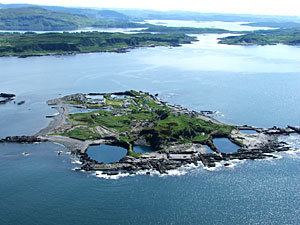Gaelic name Eilean Èisdeal OS grid reference NM735172 Highest elevation 38 m | Meaning of name Uncertain Population 59 Area 25 ha | |
 | ||
Island groups British Isles, Slate Islands, Inner Hebrides | ||
Easdale a wild community
Easdale (Scottish Gaelic: Eilean Èisdeal) is one of the Slate Islands, in the Firth of Lorn, Scotland. Once the centre of the Scottish slate industry, there has been some recent island regeneration.
Contents
- Easdale a wild community
- Map of Easdale United Kingdom
- Easdale scotland
- EtymologyEdit
- HistoryEdit
- Current ownershipEdit
- Facilities and activitiesEdit
- References
Map of Easdale, United Kingdom
A ferry sails from Easdale to Ellenabeich (Gaelic: Eilean nam Beathach) on the nearby island of Seil (Gaelic: Saoil), which is separated from Easdale by only a narrow channel. Confusingly, Ellenabeich is sometimes known as Easdale as a result of its traditional connections with the island.
Easdale scotland
EtymologyEdit
In 1549, Donald Monro, "Dean of the Isles" wrote, in brief reference to Easdale, of an island "namit in the Erische Leid Ellan Eisdcalfe" However the derivation of "Eisdcalfe" and this word's etymological relationship to "Easdale" is not clear. Haswell Smith (2004) notes that eas is Gaelic for "waterfall" and dal is Norse for "valley". Nonetheless, it is not clear why either description should apply to the island which is low lying and has no waterfalls.
The Gaelic name, Èisdeal ([ˈeːʃtʲəl̪ˠ]) or Eilean Èisdeal has a long vowel and local folk legend attributes this to a derivation from èist thall "listen to that yonder". Gaelic Place-Names of Scotland states that the first element is obscure, the second Norse dalr. It is not clear if this Èisdeal shares its derivation with Gleann Èisdeal (Glen Ashdale) (Glen of Ash trees) on the Isle of Arran.
Ellenbeich is usually analysed as Eilean nam Beathach ([ˈelan əm ˈpɛhəx]) "island of the animals" but this may be a reflex of an earlier and homophonous form Eilean nam Beitheach "island of the birch trees".
HistoryEdit
Once a centre of the British slate industry, Easdale had a community of more than 500 working as many as seven quarries, some of which extended to 300 feet (91 m) below sea level. Easdale slate helped to build major cities of the British Empire and can still be seen on rooftops as far afield as Melbourne, Nova Scotia, Dunedin and Dublin. The great storm of 1850 flooded most of the quarries. Lacking any means of pumping the water away, the slate industry on the island more or less came to an abrupt end. The last slate was cut in the 1950s and the once active quarries are little more than still pools which provide a safe haven for a wide variety of flora and bird life.
Nearby the former island Eilean-a-beithich once stood in the Easdale Sound between Easdale and Seil; however, it was quarried to a depth of 249 feet (76 m) below sea level leaving only the outer rim of the island. This was eventually swept away by the sea and little visible sign of the island now remains.
By the early 1960s, the population had dwindled to only four people and the island appeared doomed. Descendants of the original quarrymen, along with others from around the world, have moved to Easdale to create a model of island regeneration. The island now has a population of around sixty people and is the smallest permanently inhabited island of the Inner Hebrides.
British indie rock band Florence and the Machine filmed their double-feature music video for their singles "Queen of Peace" and "Long & Lost" on the island, with the videos using the villagers as the cast.
Current ownershipEdit
The island is owned by Jonathan Feigenbaum, who succeeded his late father Clive Feigenbaum (the former chairman of Stanley Gibbons). Clive created local issues of stamps, and Jonathan has continued doing this.
Facilities and activitiesEdit
The island is home to a folk museum owned and operated by the Eilean Eisdeal, a development trust, as well as a bar/restaurant called "The Puffer". Eilean Eisdeal spearheaded the renovation of the Easdale Island Community Hall, which provides a venue for a wide variety of events. According to Mike Scott of the Waterboys: "The Hall itself is magical. From the first sighting of its pyramid roof and arced frontispiece across the water to stepping off its stage at the end of the concert, it cast a spell on us."
In 2005 the local authority, Argyll and Bute Council, discussed plans to build a bridge between the island and Seil, linking the island to the mainland by road, despite there being no roads on Easdale. A company who operate high speed boat trips to view wild life and other local places of interest in the area have their base on Easdale.
The World Stone Skimming Championship has taken place annually in September on Easdale since 1997. In 2012 the event came under threat after Jonathan Feigenbaum requested £1,000 for using the slate quarry the championship uses. The competition only went ahead after the Press and Journal newspaper offered to pay the fee. A community buyout of the island by residents is now under consideration. Mike Russell, MSP for Argyll and Bute said: "Not every community will achieve it and not every community should achieve it. But it is a live issue and becomes even more live in circumstances such as these."
